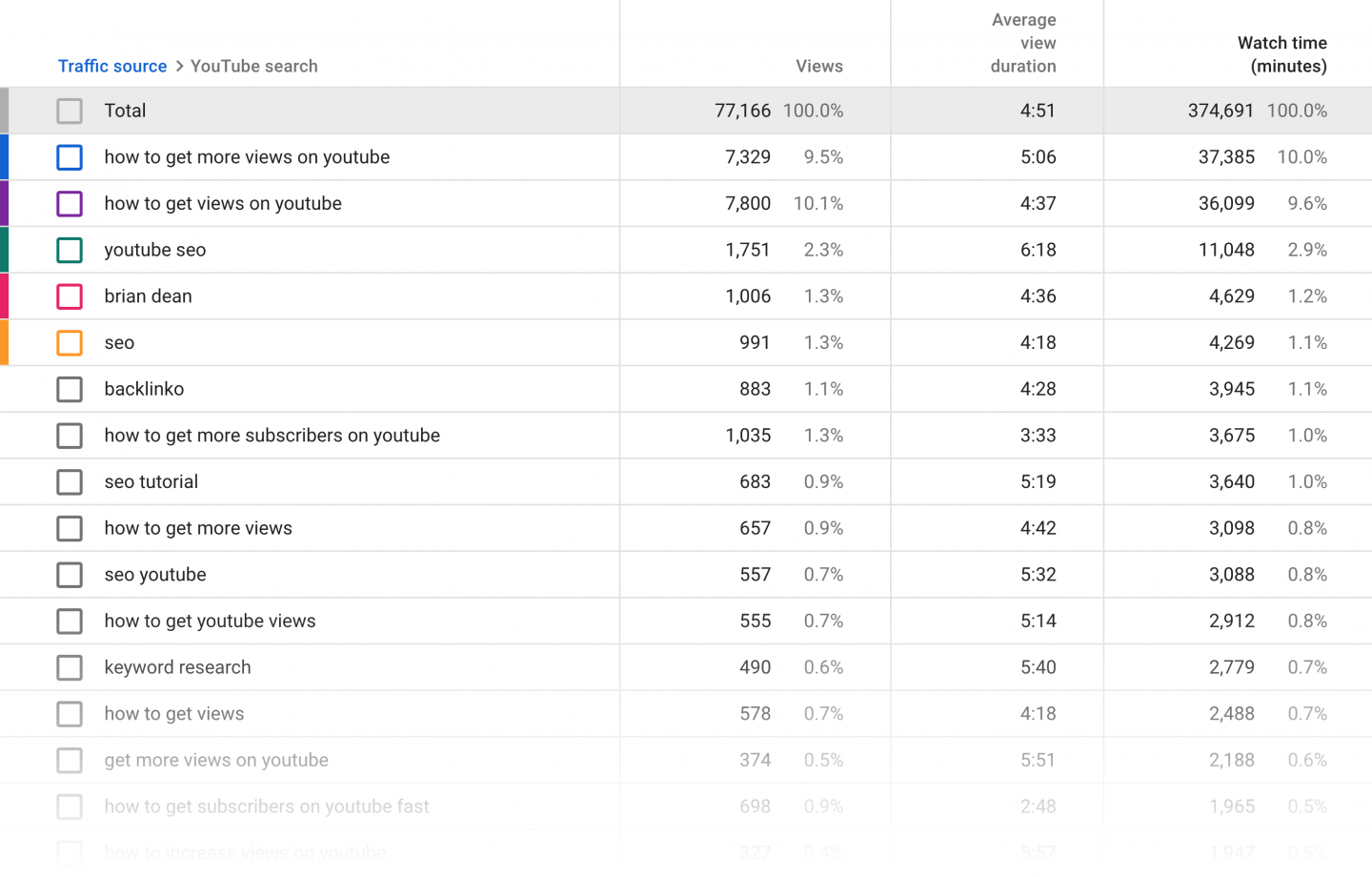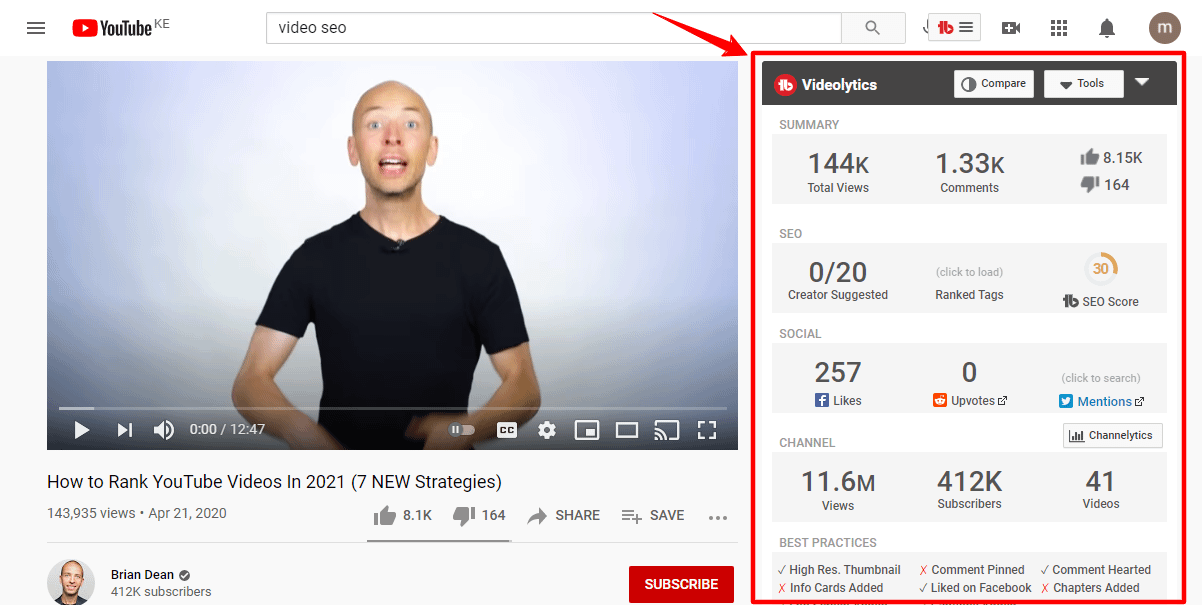Video SEO: The Ultimate Secret Guide to Video & SEO
Video SEO is a tough nut to crack especially for newcomers. Not to worry though: this guide shows you exactly how to rank your videos on the biggest search engines.

If you'd like to rank your videos on YouTube, Google, and other search engines, you're in the right place.
Video is big. It's a great way to drive traffic to your site, pass your brand message, engage users, and boost your sales.
However, video SEO and ranking videos on YouTube and Google among other search engines isn't exactly straightforward.
It's a tough nut to crack especially for newcomers. Not to worry, however, because today's guide shows you exactly how to rank your videos on YouTube.
That way, you increase your video views and drive more targeted traffic to your website and convert more leads into paying customers.
Without further ado, let's dive right in since there is a lot to cover.
Video SEO: How to Rank Videos and Get More Views
The tips you're about to learn here today are endorsed by video SEO experts such as Brian Dean of Backlinko.
All the tips are practical, and many users have applied them to increase views, watch time, and subscribes on their channels.
Let's start.
Video Keyword Research
As with blog articles and other types of content you optimize for search engines, the first step to ranking your videos is keyword research.
To rank your videos on YouTube, you must first research the keywords that your target audience is actively using to find your videos.
And not just any keywords, but popular but relevant video keywords that generate a ton of views for you as well as your competitors.
Unknown to many people, finding the right video keywords to optimize is simple. You don’t need prior experience or technical knowledge to mine keywords.
You just need to use the tools that are already at your disposal. Here are my top five tools.
YouTube Suggest

YouTube Suggest is one of the easiest (and free) tools to generate highly targeted keywords for your video SEO campaign.
It works just like Google Suggest – simply enter your main keyword in YouTube search box, and YouTube will suggest related keywords that people are searching for.
It’s a huge source of ideas and you don’t have to wonder if the keywords are relevant and popular.
Why? Because YouTube is literally showing you the exact keywords people are using.
VidIQ Keyword Research

If you’re looking for a great keyword research tool for YouTube, you can’t go wrong with VidIQ.
It’s one of the best tools to discover incredible keywords and topic ideas for your videos. Plus, it’s easy to use.
To get started, create an account on the official VidIQ website and enter your main keyword. VidIQ kicks in and generates an extensive list of relevant keywords.
As simple as A, B, C.
YouTube Studio

Another tool that’s a golden opportunity as far as deriving amazing keywords goes is your YouTube Studio traffic source report.
It shows you the keywords that you are already ranking for, and other keywords that viewers are using to find your content.
YouTube Studio is a fantastic source of keywords especially if your YouTube channel has some traction.
It’s a great place to start your keyword research if you’d like to create new videos or optimize older videos for more views.
YT Cockpit

The internet is the proverbial gift that never stops giving. There is no shortage of powerful video SEO tools such as YT Cockpit.
YT Cockpit is a premium tool designed specifically for YouTube. It’s a keyword research tool that offers you a lot of keyword metrics such as CPC, search volume, and views.
On top of that, YT Cockpit helps you to analyze your competition. It shows you the number of likes, average video duration, and comments for each video that ranks for a specific keyword.
TubeBuddy

Finally, you have TubeBuddy, a nifty and free browser extension that comes in handy if you’d like to see the tags that your competitors are using for their videos.
Why is that important? While tags aren’t as important as they used to be, they are a reliable source of keyword ideas.
Also, YouTube still uses tags to determine what your video is all about. That offers you a fantastic opportunity to optimize your videos around your keywords.
Additionally, TubeBuddy offers you a lot of important info. I’m talking about the number of likes a video has on social media, best practices used, average SEO score, and much more.
With all the above tools, finding the right video keywords to optimize is as easy as pie. Now that you can generate keywords like a pro, let us move on to the next part.
Create Exceptional Videos
You must create exceptional videos if you ever want to rank. A crappy video won’t take you to the top of search results.
But what is an “exceptional” video? An “exceptional” video to one guy might make the next guy pull out his hair.
Not to worry. YouTube uses some ranking signals to determine if your video is exceptional. They are:
- Audience retention
- Click-through rate (CTR)
- Engagement
- Session time
- Watch time
You must keep the above metrics in mind if you ever dream of creating an awesome video that ranks.
Let us go over each ranking signal briefly.
Audience Retention
One of YouTube’s biggest ranking signals is audience retention. Audience retention is the percentage of your video that people watch.
Without a doubt, you want people to watch more of your video. The more they watch, the better.
That said, how do you take full advantage of your audience retention? Well, it’s super-duper easy.
For starters, work on your video intros. You want to pay utmost attention to the first 15 seconds of your video.
That’s when you hook your viewer. If you fail to hook your viewers within 15 seconds, you’re done.
Secondly, study your audience retention reports to determine when audience retention peaks and drops.
Then, do more of what is working and eradicate whatever is sending people away.
Thirdly, use what Brian Dean calls “pattern interrupts.” These are moments in your video when you change things up with a joke, anecdote, and anything that resets people's attention.
Add two or three “pattern interrupts” in your video to break the monotony that sends people away.
Finally, creating an interesting or valuable video that helps your viewers is the best way of boosting audience retention.
Moving on swiftly.
Click-Through Rate (CTR)
Another metric that YouTube uses to rank your videos is your click-through rate or CTR in short.
For those still wet behind the ears, click-through rate is the percentage of people who click on your video in YouTube search results.
Say, if 10 people searched your keyword and two clicked on your video, your CTR is 20%. Simple, right?
Now, you want people to click on your video (and not someone else’s) every time they search for your keyword.
It tells YouTube that people love your video, which translates to better ranking. But how do you get more people to click on your video in YouTube searches?
Well, you create captivating thumbnails and titles that stand out from the other results. It is as simple as that.
Videos with excellent thumbnails and titles get many clicks, which is how they keep ranking higher in search results.
User Engagement
Quick question: Which video do you think will rank higher? A video with 1k comments and 2k likes, or a video with 10 likes? The former, of course.
User engagement is yet another metric that YouTube uses to determine if your video is exceptional. It is also how you can climb up the search results.
It’s exactly why YouTube measures how many viewers:
- Comment
- Like
- Share
- Subscribe
- Embed
- Add your videos to playlists
To rank higher, you need actively boost engagement on your videos. The more engagement your videos get, the better.
How do you maximize user engagement?
It’s simple actually. As the saying goes: ask and you shall receive. Ask your viewers to comment, like, and share. Give them something specific to comment on, and you’ll notice more comments.
And when they do comment, take the time to reply to the comments. Why? Because replying to comments encourages more people to comment.
Secondly, don’t forget (or be afraid) to ask people to subscribe to your channel. Add a clear CTA at the end of your video urging people to subscribe to your channel.
Session Time
Let us talk about another YouTube ranking signal: session time. What is session time? Session watch time is how long users spend on YouTube after watching your video.
In fact, YouTube confirmed this ranking signal:
“If viewers are watching more YouTube, it signals to us that they’re happier with the content they’ve found. It means that creators are attracting more engaged audiences. It also opens up more opportunities to generate revenue for our partners.”
That means YouTube rewards you with higher rankings if your videos keep people on the platform.
Optimizing for session time is pretty straightforward. Any video creator can do it before the next guy finishes a sandwich.
How?
Firstly, create video playlists. If you have videos that cover the same topic or theme, put them in a single playlist. Your session time increases when someone watches that playlist.
Secondly, use YouTube’s End Screen feature to add links to your other videos at the end of each video.
Both approaches will help viewers discover more of your videos and spend more time on YouTube.
Are you following?
Total Watch Time
Total watch time (TWT) is debatably YouTube’s numero uno ranking signal. That’s right, YouTube uses TWT to determine whether your video is awesome and rewards you accordingly.
Total watch time is the amount of watch time your videos get. The data is available in your YouTube Studio dashboard.
While creating long videos doesn’t necessarily translate to a better ranking, a long video can help you maximize total watch time.
Think of it this way. Let’s say you create two videos: Video that is 10 minutes long and video B that is five minutes long.
If your viewers watch 40% of each video, video A will garner more watch time than video B. Top ranking videos are usually long.
Pro Tip: Don’t create long videos just so you can boost your rankings. Create exceptional videos that provide value.
In other words, create videos that maximize audience retention, as we discussed earlier in the post.
Now that you can create exceptional videos that people want to watch, let us optimize your video around keywords that viewers use on YouTube and Google.
Optimize Your Video
See how you optimize your blog posts, images, and other content you create? Well, videos are not any different.
You must optimize various parts of your video to maximize the possibility of people finding it and watching.
How?
Start by optimizing your video title. It’s simple; just add your target keyword in your title, preferably at the beginning.
On top of that, make sure your title is compelling to boost your click-through rates. We said this earlier, but don’t use click-bait titles that have nothing to do with the contents of your video.
Next, you need to write descriptions for your videos. 250 to 300 words is fine, just include your target keyword two to three times.
Your video description helps YouTube learn more about your video. It also helps your videos appear in Suggested Videos.
Additionally, YouTube shows the first 125 characters of your video description in search results, so it’s vital to make the description compelling to boost CTR.
Thirdly, add relevant tags to your video. Make your target keyword one of the tags and add related keywords as tags.
Another thing, say your target keyword in your videos. Nowadays, YouTube generates transcripts for your videos.
Said transcripts help YouTube better understand what your video is all about. When your keyword in your video, YouTube captures the keyword.
For even better results, you can upload your own keyword-ready transcript to YouTube for better results.
When writing an about section for your channel (you know, when you’re creating the channel), include your target keywords as well.
You can comfortably optimize your video. Now you’re ready for the next tip.
Promote Your Videos
I know, I know – you’re like “How is promoting my video part of SEO?” “Dude, aren’t you supposed to be doing SEO, so that you can get more views without direct promo?”
We’ve covered the ranking signals that YouTube uses. To measure these signals, you need to generate views for your videos.
And what do you do to generate views? You guessed it right – you promote the hell out of your videos like a mad man.
How else will you and YouTube measure how your video is performing? How will you rank higher in YouTube without views?
So, how do you promote your videos? Here are a couple of easy ideas.
Share your video on Quora and other Q&A sites where people are desperate for information. Just don’t spam people.
Instead, answer a relevant question and link to your video at the end. Anybody who needs information will watch the video.
Secondly, you can link to your video in your email signature. Email is already effective as it is. Why not use it to drive more views to your video?
If you have a blog post that could use a video, why are you not embedding one already? It’s a terrific way to create more value and boost views on your videos.
Finally, you want to share your video on Facebook, Twitter, and Pinterest, among other social media sites. That’s rather obvious, don’t you think?
Final Words
With the above tips, video SEO needn’t be a challenge. You have all the advice you need to start ranking your videos like a boss.
What about you? How do you rank videos on YouTube and other search engines? Any favorite tools or tips?
